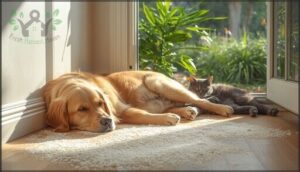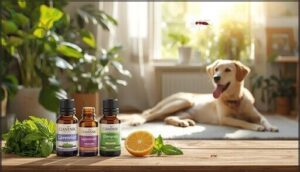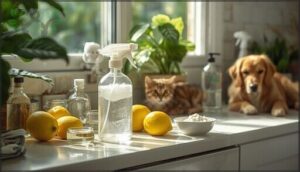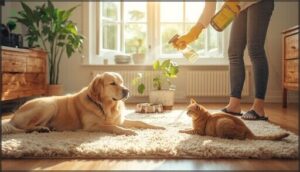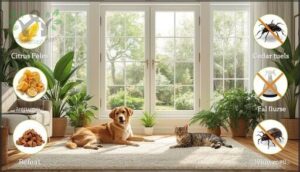This site is supported by our readers. We may earn a commission, at no cost to you, if you purchase through links.
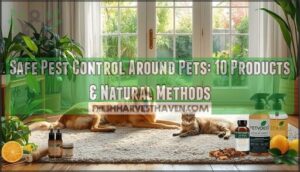
This scenario plays out more often than pet owners realize because many pesticides marketed as “safe” still contain chemicals that can poison your dog or cat through their paws, fur, or curious licks.
The good news is you don’t have to choose between a pest-free home and your pet’s safety. Effective alternatives exist that eliminate bugs without putting your animals at risk.
Table Of Contents
- Key Takeaways
- Why Standard Pest Control Risks Pet Safety
- What to Look for in Pet-Safe Pest Control
- Natural and Non-Toxic Pest Control Remedies
- Safe Pest Control Practices for Pet Owners
- Top 10 Pet-Safe Pest Control Products
- 1. Wondercide Peppermint Natural Indoor Pest Control
- 2. Ortho Home Defense Bed Bug Killer
- 3. Bed Bug Killer EcoVenger 16oz
- 4. Wondercide Outdoor Pest Control Spray
- 5. Premo Guard Bed Bug Killer
- 6. Hygea Natural Bed Bug Spray
- 7. EcoVenger Natural Ant and Insect Killer
- 8. BugMD Rodent Ready To Use
- 9. Zevo Insect Killer Spray Safe
- 10. Wondercide Lemongrass Flea Tick Mosquito Spray
- Preventing Pest Problems Without Harming Pets
- Frequently Asked Questions (FAQs)
- Are pest control products safe for pets?
- What is a safe bug control option for pets?
- Where should a pet-safe pest trap be placed?
- What are the best pest control products for pets?
- Is bug spray safe for pets?
- How do I choose a pet-safe pesticide?
- How long do natural pest repellents remain effective?
- Are ultrasonic pest devices safe for pets hearing?
- Should pets wear protective gear during outdoor treatments?
- Conclusion
Key Takeaways
- Many common pesticides contain organophosphates, pyrethrins, DEET, and metaldehyde that can poison pets through skin contact, inhalation, or ingestion, with cats particularly vulnerable due to their inability to metabolize certain chemicals and young or small animals facing higher toxicity risks from their size and developing organs.
- Plant-based alternatives like diatomaceous earth, essential oils (when properly diluted and species-appropriate), and products containing cedarwood or peppermint oils provide effective pest control without toxic chemical exposure, though they require more frequent reapplication than synthetic options.
- Prevention through yard maintenance, sealing entry points, removing standing water, and regular pet checks for fleas and ticks reduces pest problems without requiring chemical treatments, making it the safest long-term strategy for homes with pets.
- When pesticide use becomes necessary, pet safety depends on choosing products with transparent ingredient lists, following re-entry guidelines (typically 2-4 hours drying time), removing pet belongings from treatment areas, and watching for poisoning symptoms like tremors, excessive drooling, vomiting, or difficulty breathing that require immediate veterinary attention.
Why Standard Pest Control Risks Pet Safety
When you reach for that can of bug spray, you mightn’t think twice about what’s inside. But many common pest control products contain chemicals that can seriously harm your pets.
Let’s look at why typical pesticides pose real risks to the animals you love.
Common Chemicals Harmful to Pets
When you reach for that can of bug spray, you might not realize you’re holding something that could send your pet to the emergency vet. Many common pesticides contain toxic chemicals that pose serious pesticide risks for pets, from pesticide ingestion to fume inhalation. Here’s what you need to watch for:
- Organophosphates and carbamates cause nerve damage, leading to tremors and seizures
- Pyrethrins and pyrethroids trigger skin absorption issues, especially in cats with vulnerable liver toxicity
- Metaldehyde in slug bait causes fatal poisoning through accidental ingestion
- DEET in mosquito repellents leads to neurological problems and grooming risks
- Rodenticides cause internal bleeding when pets contact harmful chemicals for pets
These substances create multiple exposure pathways, making pesticide poisoning a real threat in homes using standard pest control.
How Pets Get Exposed to Pesticides
Your pet doesn’t need to eat poison directly to end up in danger—pesticides find their way into their system through everyday activities you mightn’t think twice about.
Ingestion risks happen when pets lick treated surfaces or walk through sprayed areas. Fume inhalation occurs during application, while skin absorption happens through paw pads.
Grooming hazards arise when pets clean pesticide residue off their fur.
Chronic exposure builds up over time, making understanding pesticide exposure critical for protecting pets from pesticides.
Symptoms of Pesticide Poisoning in Pets
Recognizing poisoning symptoms fast can mean the difference between life and death. About half of pesticide poisoning cases cause mild to moderate signs, but roughly 10% end in death. Dogs make up 71% of these incidents, cats about 16%. Symptoms appear within minutes or may take days, depending on the chemical and dose.
About half of pesticide poisoning cases in pets cause mild symptoms, but roughly 10% prove fatal—and signs can surface within minutes or take days to appear
Watch for these warning signs:
- Muscle tremors and seizures — especially from pyrethrins and organophosphates
- Excessive drooling — a telltale neurological sign linked to organophosphate exposure
- Vomiting and diarrhea — often the first gastrointestinal issues you’ll notice
- Labored breathing or wheezing — respiratory distress hits cats particularly hard
- Weakness and loss of coordination — lethargy signals systemic toxicity
Early recognition of these exposure symptoms improves survival. If you spot any signs of pesticide poisoning, seek immediate veterinary attention immediately.
Pets Most Vulnerable to Chemical Exposure
Not all pets face the same level of danger from pesticides, and knowing which animals are most at risk helps you take smarter precautions. Kittens and puppies absorb toxins faster due to immature liver function. Small animals like rabbits and birds face higher pesticide risks because of their size and metabolism. Breed sensitivities also matter—certain breeds process chemicals differently, increasing vulnerable animals’ exposure levels.
Identifying pesticide exposure symptoms early and preventing pet poisonings starts with understanding which companions need extra protection.
| Pet Type | Why They’re at Risk |
|---|---|
| Kittens and Puppies | Developing organs can’t detoxify chemicals efficiently |
| Cats (all ages) | Lack specific liver enzymes to break down pyrethrins and permethrins |
| Small breeds | Higher pesticide concentration per body weight |
| Birds and reptiles | Extremely sensitive respiratory systems absorb airborne toxins rapidly |
| Senior pets | Weakened liver and kidney function slows toxin elimination |
What to Look for in Pet-Safe Pest Control
Not all pest control products are safe for your furry family members. When you’re shopping for solutions, knowing which ingredients to avoid and which methods work without harm makes all the difference.
Let’s look at what keeps your pets protected while eliminating unwanted pests.
Harmful Chemicals to Avoid (e.g., DEET, Metaldehyde)
When you scan labels, watch out for ingredients that turn your home into a hazard zone for pets. Some common chemicals pose serious dangers, even in small amounts. Here are the toxic substances you need to avoid:
- DEET – Found in mosquito repellents, DEET toxicity can cause vomiting, tremors, and seizures in pets, with dogs showing neurologic symptoms at high exposures.
- Metaldehyde – Used in slug baits, metaldehyde hazards are severe; just four teaspoons can kill a 30kg dog.
- Neonicotinoids – These account for 83% of pesticide exposure in cats, with neonicotinoid impact reaching dangerous urinary concentrations.
- Organophosphates and Pyrethroids – Organophosphate risks include cancer links, while pyrethroid concerns center on neurotoxic effects, especially in cats whose livers can’t process these harmful ingredients effectively.
These pesticide risks aren’t theoretical—they’re documented causes of pet poisonings nationwide. Metaldehyde ingestion in dogs can lead to fatal outcomes, with respiratory failure being a primary concern.
Choosing Pet-Friendly Pest Control Methods
Once you’ve identified the toxins to avoid, your next step is choosing pest control methods that actually work without putting your pet at risk. Safe ingredient selection starts with pet-safe pest control products containing plant-based formulas or diatomaceous earth. Application method matters—sprays allow targeted use, while granules work outdoors.
For long-term pest control, consider professional pest control services trained in pet-friendly pest control options. Cost-effectiveness analysis shows choosing pet-friendly pesticides prevents vet bills while keeping pests away.
Natural and Non-Toxic Pest Control Remedies
You don’t have to rely on harsh chemicals to keep pests away from your home and pets. Natural remedies can work just as well, using ingredients you might already have or can easily find.
Let’s look at some proven methods that protect your furry family members while keeping unwanted visitors at bay.
Using Diatomaceous Earth for Home and Yard
Diatomaceous earth works like microscopic broken glass to insects, but it’s completely harmless to your dog or cat. This powdery substance, made from fossilized diatoms, dehydrates bugs with exoskeletons and kills them within 24 hours. Always choose food-grade DE for safety around pets.
How to Use DE for Petsafe Pest Control Methods:
- Indoor DE Application: Sprinkle a thin layer along baseboards, under appliances, and in cracks where insects hide.
- Yard Care: Dust DE around garden beds, entry points, and outdoor pet areas to create natural pest control barriers.
- Pet Bedding: Add small amounts to kitty litter or around pet sleeping areas to control fleas naturally.
- DE Benefits: Works on ants, roaches, fleas, and other crawling pests without toxic chemicals.
- DE Safety: Keep dry for effectiveness; reapply after rain or cleaning treated areas.
Essential Oils for Pest Repellency
Essential oils offer natural pest control, but not all are safe for your furry friends. Cats lack the liver enzymes to process certain essential oils, making them especially vulnerable. Dogs tolerate more oils, but you still need careful application methods and safe dilution rates.
Essential Oils for Pest Control: Safety Guide
| Oil Type | Pet Sensitivity | Safe Application |
|---|---|---|
| Peppermint | Low for dogs; high for cats | Dilute 1-2 drops per cup of water; spray surfaces, not pets |
| Lavender | Generally safe for both | Use in diffusers away from pet sleeping areas |
| Lemongrass | Moderate for both | Outdoor application only; keep pets away 2-3 hours |
| Citronella | Moderate for dogs; high for cats | Use candles outdoors; never apply directly to pets |
Oil combinations can boost effectiveness against mosquitoes, ants, and flies. Always test plant-based natural remedies in small areas first, and watch your pets for drooling, vomiting, or lethargy after introducing any essential oils for pest control into your home.
Beneficial Plants and Natural Predators
Your garden can become your best defense system, with certain plants naturally keeping pests at bay while offering zero risk to your pets. Companion planting creates a living barrier, while mosquito-repelling plants like lavender and lemon balm offer natural pest control solutions without chemicals.
Beneficial additions include:
- Ladybugs – These natural predators devour aphids and other garden pests, making them essential for organic pest control methods
- Nematodes – Microscopic allies that eliminate grubs and cutworms while improving soil health, offering safe nematode benefits for lawns
- Predator habitats – Birdhouses and bee hotels attract insects and animals that control pest populations using plant-based natural remedies
Homemade Pest Control Solutions
You don’t need a chemistry degree or expensive products to protect your home from pests, just a few common household ingredients mixed with the right know-how.
Simple DIY pest sprays using vinegar solution, water, and dish soap create effective natural pest control remedies that work against ants and flies without endangering your pets, making homemade pest control solutions both affordable and safe.
Safe Pest Control Practices for Pet Owners
Even the safest pest control products won’t protect your pets if you don’t use them correctly. How you prepare your home, apply treatments, and manage the hours after application can make the difference between a pest-free space and a trip to the vet.
Let’s walk through the key steps that keep your four-legged family members safe while you tackle those unwanted visitors.
Preparing Your Home Before Treatment
Before you spray or spread anything in your home, take a few minutes to move your pet’s essentials—food bowls, favorite toys, and bedding—away from the areas you plan to treat. Cover fish tanks with plastic sheeting and disable air systems to prevent fumes from circulating throughout your house.
Secure food storage containers and ensure you have a clear plan for re-entry timing. These sanitation and safety practices will protect your pets during home maintenance while effectively preparing your home for pest control.
Safe Application and Re-entry Guidelines
Once you’ve set up your space properly, timing your application and keeping pets away for the right amount of time can make the difference between safe pest control and an emergency vet visit. Always follow product labeling for safe reentry time—most products require 2-4 hours of drying before pets return.
Open windows to meet ventilation needs, and wipe treated surfaces with damp cloths. Store products in secure storage immediately after use, maintaining pesticide safety for pets through these safe practices while minimizing pesticide exposure.
Cleaning and Preventing Future Infestations
After treatment and reentry, keeping your home clean and sealing entry points stops pests from moving back in. Seal entryways like cracks and gaps, and maintain your yard by removing debris and standing water.
Regular cleaning and sanitation practices eliminate food sources that attract pests. Use natural barriers like diatomaceous earth around doorways, and practice safe storage of pet food to support pest prevention long-term.
Top 10 Pet-Safe Pest Control Products
You’ve seen how to prepare your home and apply pest control safely.
Now let’s look at specific products that won’t put your pets at risk. These ten options combine effective pest control with ingredients that keep your furry family members safe.
1. Wondercide Peppermint Natural Indoor Pest Control
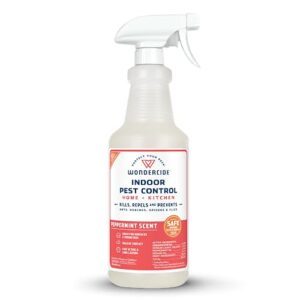
Wondercide Indoor Pest Control Spray stands out for its peppermint efficacy, backed by lab testing, showing 99–100% mortality rates against fleas, larvae, and eggs within 24 hours. This natural spray uses food-grade peppermint oil without phenols, making it safe around dogs and cats when you follow application guidelines.
Independent studies confirm it’s as effective as DEET for repelling mosquitoes while tackling over 100 household pests, from ants to spiders. User experience reports highlight reduced pest presence and a pleasant scent, though some note it’s less effective against established flea infestations.
Apply every 2–3 days for best results, avoiding your pet’s eyes, nose, and mouth.
Best For: Pet owners looking for a natural, plant-based pest control solution that’s safe to use around dogs and cats while effectively killing and repelling common indoor pests like ants, roaches, spiders, and fleas.
- Lab-tested with 99–100% mortality rates against fleas (adults, larvae, eggs) within 24 hours and proven as effective as DEET for repelling mosquitoes
- Safe formulation using food-grade peppermint oil without phenols or artificial chemicals, approved for use around pets when applied correctly
- Tackles over 100 household pests with a ready-to-use spray that requires no mixing or dilution
- May be less effective against established flea infestations compared to chemical treatments, according to some user feedback
- Requires reapplication every 2–3 days for ongoing pest prevention, which can be time-consuming
- Strong oily consistency and pungent odor that can linger for a day, with potential to stain unsealed wood flooring
2. Ortho Home Defense Bed Bug Killer
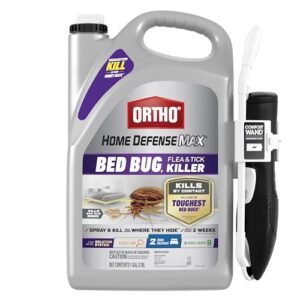
Ortho Home Defense Bed Bug Killer targets pyrethroid-resistant bed bugs with three active ingredients: bifenthrin, imidacloprid, and piperonyl butoxide. Laboratory testing confirms roughly 50% direct-contact mortality, and it eliminates eggs, fleas, and ticks along mattress seams and baseboards.
Product efficacy depends on proper application guidelines—spray surfaces until slightly damp, then keep pets away for 2–3 hours until everything dries. Safe for pets once dry, but small mammals face serious risks even after drying.
Consumer reviews praise the battery-operated wand’s convenience, though repeated use every two weeks maintains bed bug control without risking pesticide poisoning in your household.
Best For: Households dealing with bed bug infestations who need a spray that targets pyrethroid-resistant bugs and works in hard-to-reach spots like mattress seams and baseboards.
- Kills bed bugs, eggs, fleas, and ticks on contact, including pyrethroid-resistant strains
- Battery-operated wand makes it easy to treat cracks, crevices, and tight spaces
- Safe for pets once surfaces dry completely (2–3 hours)
- Requires reapplication every 2 weeks to maintain effectiveness
- Dried residue offers weaker control than direct spray contact
- Not safe for small mammals like hamsters or guinea pigs even after drying
3. Bed Bug Killer EcoVenger 16oz
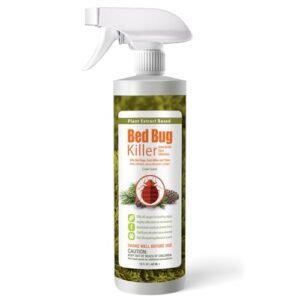
EcoVenger Bed Bug Killer delivers plant-powered bed bug control with clove oil and peppermint oil, eliminating all life stages on contact. University testing confirms 100% mortality across eggs, nymphs, and adults, with residual protection lasting up to 14 days.
This USDA Biobased spray meets dermatological safety standards, making it safe for pets and children once dry on mattresses and furniture. The cedarwood scent dissipates quickly, and IPM compatibility allows you to integrate it into broader pest management strategies without toxic pesticides in your home.
Best For: Families with children and pets seeking a non-toxic, plant-based solution for killing bed bugs at all life stages with proven university-tested effectiveness.
- Achieves 100% mortality on contact across all bed bug life stages, including resistant strains, with up to 14 days of residual protection
- Safe for immediate use on mattresses and furniture with no harsh chemicals—USDA Biobased and dermatologically tested for homes with kids and pets
- Fast-dissipating cedarwood scent and plant-powered formula work within IPM strategies without toxic pesticides or hazardous waste concerns
- Requires repeated applications for heavy or ongoing infestations, limiting effectiveness as a standalone solution
- Strong cedar scent may trigger headaches or discomfort in sensitive individuals during application
- Milky formula can stain dark surfaces and is ineffective against pests like mosquitoes or roaches
4. Wondercide Outdoor Pest Control Spray
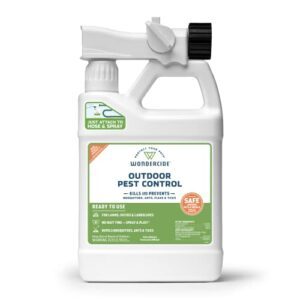
For broad outdoor protection, Wondercide Outdoor Pest Control Spray provides cedar-based pest repellency across lawns, gardens, and patios using a simple hose attachment. This pet-safe pest control solution covers up to 5,000 square feet per 32-ounce bottle, targeting mosquitoes, fleas, ticks, and ants without synthetic chemicals.
The cedarwood scent remains mild while repelling pests safely around dogs, cats, and children once dry. Reapplication needs increase after heavy rain, but frequent treatments maintain consistent outdoor pest control for pets throughout warmer months when flea and tick control matters most.
Best For: Pet owners who want a natural, hose-attached pest control solution for large outdoor areas where their dogs, cats, and kids spend time.
- Safe around pets, children, and beneficial insects like bees once it dries, using natural cedar oil instead of harsh synthetic chemicals.
- Easy application with a hose attachment that covers up to 5,000 square feet, making it simple to treat lawns, patios, and play areas quickly.
- Repels multiple pests including mosquitoes, fleas, ticks, ants, and roaches with a mild cedarwood scent that won’t overwhelm your yard.
- Requires more frequent reapplication than chemical sprays, especially after heavy rain or watering, which increases the ongoing cost.
- May not kill pests as effectively as DEET-based products, focusing more on repelling them rather than eliminating infestations.
- Can get expensive for regular use on large properties, with the 32-ounce bottle covering only 5,000 square feet per treatment.
5. Premo Guard Bed Bug Killer
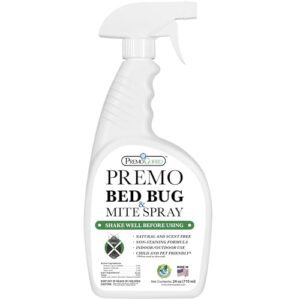
Premo Guard Bed Bug Killer delivers natural, unscented indoor pest control that eliminates bed bugs, mites, and fleas through 24 fluid ounces of plant-based liquid spray. You’ll find this pet-safe pest control solution effective on mattresses, furniture, carpets, and pet bedding without leaving stains or harsh odors that trigger pet sensitivity concerns.
Application safety matters most with this formula—it’s safe for pets and children once surfaces dry completely. User reviews highlight its ingredient analysis showing natural components, though some noted the sprayer mechanism occasionally fails after repeated use.
For bed bugs threatening your home, you can treat multiple surfaces knowing your pets won’t face chemical exposure risks common with conventional pesticides.
Best For: Pet owners dealing with bed bugs or mites who need a natural spray that won’t harm their animals or leave chemical residues on furniture and bedding.
- Natural, unscented formula that’s safe around pets and children once dry, avoiding harsh chemicals that trigger sensitivities
- Works on multiple surfaces including mattresses, carpets, furniture, and pet bedding without leaving stains
- Kills bugs in all life stages, giving you comprehensive control over infestations
- Some users report it doesn’t work as expected for certain pest types, particularly mites
- Sprayer mechanism may fail after just a few days of use, forcing you to transfer the liquid
- Often requires repeated applications to see results, which means you’ll go through bottles faster than expected
6. Hygea Natural Bed Bug Spray
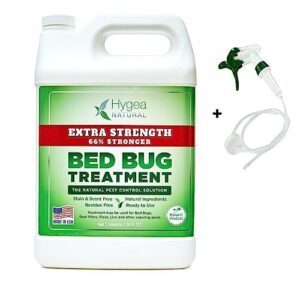
Hygea Natural Extra Strength Bed Bug Mite Spray harnesses natural enzymes to destroy bed bugs on contact—it’s like fighting fire with water instead of gasoline. This pet-safe formula uses SLS efficacy (3-5% Sodium Lauryl Sulfate), proven 100% effective in University of Florida studies, eliminating bed bugs, dust mites, fleas, and ticks without toxic pesticides.
Application safety remains straightforward: spray a light mist on mattresses, furniture, and carpets, then let surfaces dry before pets return. Consumer reviews praise its odorless, non-staining performance around children and animals.
The preventative benefits extend beyond active infestations—you can use it daily on luggage and bedding to stop safe products from becoming pest havens.
Best For: Households with pets and children seeking a natural, non-toxic solution to eliminate bed bugs and crawling pests without harsh chemicals or lingering odors.
- 100% effective against bed bugs on contact using natural enzymes (University of Florida-backed), kills fleas, ticks, dust mites, and lice
- Completely safe around pets and children—odorless, non-toxic, stain-free, leaves no residue on treated surfaces
- Works as both immediate treatment and daily prevention for mattresses, furniture, luggage, and washable surfaces
- Requires repeated applications since effects don’t last beyond 1-2 days—not a one-time fix for infestations
- Spray nozzle quality issues reported by some users, may need replacement to maintain effective misting
- Costs $69.99 for 24oz, which adds up quickly for large-scale or ongoing treatment needs
7. EcoVenger Natural Ant and Insect Killer
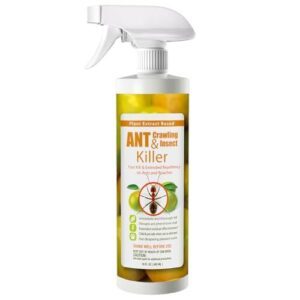
When fire ants invade, you don’t want to choose between your pet’s safety and effective control—EcoVenger Natural Ant and Insect Killer delivers both. This nontoxic formula uses natural ingredients like geraniol, cedar oil, and lemongrass oil, earning BioPreferred certification and EPA 25(b) minimum-risk status.
University efficacy testing confirms it kills house ants in one minute and fire ants in six, with residual effects preventing re-entry for over four weeks. The safety profile allows indoor pest control around pets without re-entry wait times, and application guidelines recommend spraying baseboards and entry points directly.
Its active ingredients disrupt pheromone trails, stopping infestations at the source—making it ideal for pet-safe homes.
Best For: Pet owners battling fire ants who need fast, effective control without chemical risks to animals or family members.
- Kills fire ants in 6 minutes and house ants in 1 minute with residual protection lasting over 4 weeks
- USDA BioPreferred certified with natural ingredients (geraniol, cedar oil, lemongrass oil) safe for pets, children, and the environment
- No re-entry wait time required and effective against pesticide-resistant insects
- Some users report sprayer malfunctions affecting product delivery
- Strong natural scent may be unpleasant indoors for sensitive individuals
- Outdoor residual effectiveness is lower than indoor performance and may require repeated applications
8. BugMD Rodent Ready To Use
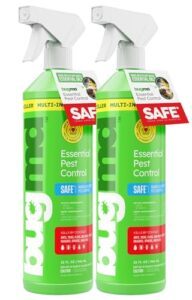
While EcoVenger addresses ants, BugMD Rodent Ready To Use targets a different problem—mice and rats—without endangering your four-legged family.
This plant-powered formula uses cottonseed oil and clove oil to kill home invaders like ants, fleas, mosquitoes, and roaches in seconds. It allows safe application on wood, carpet, and fabrics, both indoors and outdoors.
You’ll appreciate the ready-to-use spray that controls the pest lifecycle by killing eggs, larvae, and adults on contact. It’s adaptable for bathrooms, bedrooms, pet areas, and gardens.
Just be aware that some users report skin reactions due to allergies, so test carefully if your household has sensitivities. This pet-safe pest control option delivers fast results across multiple pest types without harsh chemicals.
Best For: Homeowners dealing with multiple pest types (ants, fleas, roaches, mosquitoes) who want a plant-based, fast-acting spray safe for use around pets and on various surfaces.
- Kills pests in seconds using cottonseed and clove oils, eliminating eggs, larvae, and adults on contact across multiple species.
- Ready-to-use formula works on wood, carpet, and fabrics both indoors and outdoors without mixing.
- Safe for pet areas and can target pests resistant to conventional insecticides.
- May cause skin reactions in people with allergies to the plant-based ingredients.
- Only kills on contact rather than deterring pests from returning, so repeated applications are necessary.
- Large infestations require multiple bottles and additional cleaning efforts like washing bedding.
9. Zevo Insect Killer Spray Safe
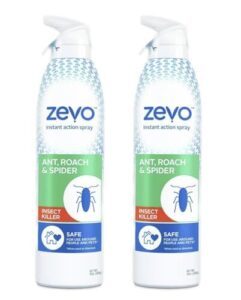
For a fast-acting insecticide you can trust near dogs and cats, Zevo Insect Killer Spray Safe relies on essential oils—geraniol, rosemary oil, and cornmint oil—to kill ants, roaches, and spiders on contact.
These ingredients disrupt insect nervous systems but remain low-risk for most pets when you follow the label. Don’t spray directly on your pet’s fur or skin; accidental exposure should be rinsed with soap and water. Keep birds, reptiles, and aquatic pets out of treated areas, since essential oils can irritate sensitive species.
Consumer feedback confirms Zevo is widely used as a safer alternative in pet households with no severe reactions reported in dogs or cats.
Best For: Pet owners seeking a fast-acting, essential oil-based insect spray that’s safer around dogs and cats than traditional chemical insecticides.
- Uses essential oils (geraniol, rosemary, cornmint) instead of harsh synthetic chemicals like organophosphates or pyrethroids, reducing toxicity risks for most pets
- Kills up to 20 insect species on contact, including ants, roaches, and spiders, with no severe reactions reported in dogs or cats when used as directed
- Available in a rose-scented formula for indoor and outdoor use, making it versatile for spot treatments throughout your home
- Not suitable for households with birds, reptiles, amphibians, or aquatic pets due to essential oil sensitivity in these species
- Short-lived effectiveness with surfaces losing activity once dry (roughly 2–3 days maximum), requiring repeated applications for ongoing issues
- Some users report quality issues with canister design, overpowering scent, and needing multiple sprays to kill individual insects
10. Wondercide Lemongrass Flea Tick Mosquito Spray
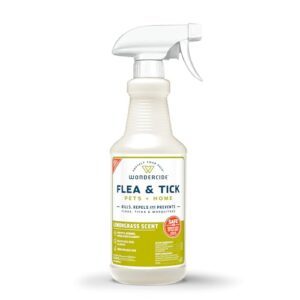
While Zevo excels at indoor crawling insects, you’ll need a different solution if fleas, ticks, or mosquitoes are hitching rides on your pet.
Wondercide Natural Flea Tick Mosquito Spray blends lemongrass efficacy with cedarwood safety. Laboratory tests show 99% flea mortality within two minutes and 100% kill rates for all three pests.
You can spray your dog or cat every two to three days, though scent sensitivity varies; some pets tolerate the lemongrass aroma, while others find it strong. Application frequency matters because natural ingredients don’t persist like synthetic chemicals.
Keep in mind that lemongrass oil may cause temporary fur discoloration on light-colored coats, which washes out after you stop using the product.
Best For: Pet owners seeking a natural, plant-based flea and tick spray that’s safe for dogs and cats of all ages and can treat both pets and living spaces.
- Laboratory-proven 99% flea kill rate within 2 minutes and 100% mortality for fleas, ticks, and mosquitoes with 99% prevention of flea egg hatching
- Safe for puppies, kittens, and senior pets with no synthetic chemicals, phenols, or artificial ingredients
- Multi-surface application works on pets, carpets, furniture, and bedding with no oily residue on most surfaces
- Requires frequent reapplication every 2-3 days since natural ingredients don’t last as long as synthetic options
- Strong lemongrass scent may be unpleasant for some pets and owners
- May temporarily discolor light-colored fur or fabrics, though it washes out after discontinuing use
Preventing Pest Problems Without Harming Pets
The best defense against pests starts before they ever become a problem. You can create a home and yard that naturally discourages insects and rodents without putting your pets at risk.
Here’s how to build lasting protection using safe, practical strategies.
Yard Maintenance and Home Sealing Tips
Your yard isn’t just a place for your pets to play—it’s often the front line of defense against pests invading your home. Simple yard and kennel spray alternatives combined with smart home sealing can stop pest problems before they start. Here’s what works:
- Mowing practices and garden maintenance – Keep grass short and trim overgrown bushes to eliminate hiding spots for ticks, fleas, and mosquitoes.
- Water removal – Dump standing water from buckets, planters, and birdbaths weekly to prevent mosquito breeding.
- Sealing entryways – Caulk cracks around windows, doors, and foundations to block ants, roaches, and rodents from entering.
These pet-safe pest control methods create natural barriers without harmful chemicals.
Regular Pet Checks for Fleas and Ticks
Most pet owners skip regular checks, but early detection makes all the difference. Run your fingers through your pet’s coat once or twice weekly, focusing on warm areas like armpits, ears, and the base of the tail where fleas and ticks prefer to hide.
If your pet goes outdoors or lives in high-risk regions, daily checks during spring through autumn are essential. Untreated pets face nearly five times higher odds of flea infestation.
Contact your veterinarian immediately if you spot pests or notice excessive scratching.
Integrating Natural Repellents and Barriers
Natural repellents work best when layered throughout your property, creating multiple barriers that pests can’t easily cross. Think of it as building a fortress your pets can safely roam while pests stay out.
- Sprinkle food-grade Diatomaceous Earth along baseboards and entry points
- Diffuse pet-safe essential oils like lavender indoors weekly
- Apply beneficial nematodes to your lawn for grub control
- Use diluted vinegar solutions on outdoor surfaces where ants gather
Creating a Pet-Safe, Pest-Free Environment
Building a pest-free home your pets can enjoy starts with combining smart prevention, natural solutions, and consistent monitoring into a routine that becomes second nature. You’ll want to store safe pest control products securely and time applications when pets are away.
Maintain preventative measures like sealing cracks and trimming vegetation. Regular monitoring helps you catch problems early, so you can use pet-safe alternatives before infestations take hold, creating a truly pest-free home where your dogs and cats stay protected.
Frequently Asked Questions (FAQs)
Are pest control products safe for pets?
Most traditional pest control products contain chemicals that pose real pet health risks. Some formulas are safer than others, but product ingredient safety matters—always read labels, choose pet-safe alternatives, and follow safe application methods strictly.
What is a safe bug control option for pets?
Diatomaceous earth stands out as one of the most effective pet-safe pest control options.
This food-grade powder dehydrates insects without harming your pets, making it ideal for indoor and outdoor use against fleas, ants, and other crawling pests.
Where should a pet-safe pest trap be placed?
Place traps along walls, behind appliances, or under furniture where pest traffic is high but pets’ reach is limited.
Prioritize trap security and child safety by choosing elevated or enclosed locations for effective indoor pest control and petsafe monitoring.
What are the best pest control products for pets?
The best products balance ingredient safety with product efficacy. Look for plant-based formulas like Wondercide or EcoVenger that use essential oils.
Check application methods and monitor pet reactions carefully to confirm long-term effects remain safe for dogs and cats.
Is bug spray safe for pets?
Bug spray is like rolling the dice with your pet’s health—spray ingredient safety matters. Most conventional sprays contain toxins that cause spray exposure symptoms in dogs and cats.
Veterinary spray advice is clear: choose petsafe bug sprays with plant-based formulas for indoor pest control for pets.
How do I choose a pet-safe pesticide?
Look for products with plant-based active ingredients like peppermint or cedarwood oil. Read labels carefully, checking for harmful chemicals such as DEET or metaldehyde.
Consider choosing pet-safe alternatives specifically labeled for use around dogs and cats, and consult your veterinarian before applying any pesticide in your home.
How long do natural pest repellents remain effective?
Most natural remedies need reapplication every few days to two weeks, depending on the specific repellent and environmental factors like rain or heat.
Organic pest control solutions don’t offer long-lasting protection compared to chemical alternatives, so regular application frequency matters for effective, pet-safe pest control.
Are ultrasonic pest devices safe for pets hearing?
Ultrasonic devices emit high-frequency sounds that may disturb pets, especially dogs and cats, who hear beyond human ranges. Pet species sensitivity varies—rodents detect even higher frequencies.
Long-term effects aren’t well-studied, so alternative deterrents like diatomaceous earth better protect animal health and pet safety.
Should pets wear protective gear during outdoor treatments?
Outdoor treatments vary in strength, so gear effectiveness depends on treatment intensity and your pet’s comfort levels. Most yard sprays don’t require protective gear if you follow safe re-entry times, but breed variations matter—short-coated breeds may need protection sooner than others, balancing pet safety with cost factors.
Conclusion
The safest pest control strategy is the one you don’t need. By maintaining sealed entry points, removing attractants, and using barrier methods, you prevent infestations before chemicals ever become necessary.
When pests do appear, prioritize safe pest control around pets by choosing products with plant-based ingredients, applying treatments correctly, and keeping animals away during application.
Your home can stay pest-free without putting your dog or cat at risk. Prevention beats poison every time.


